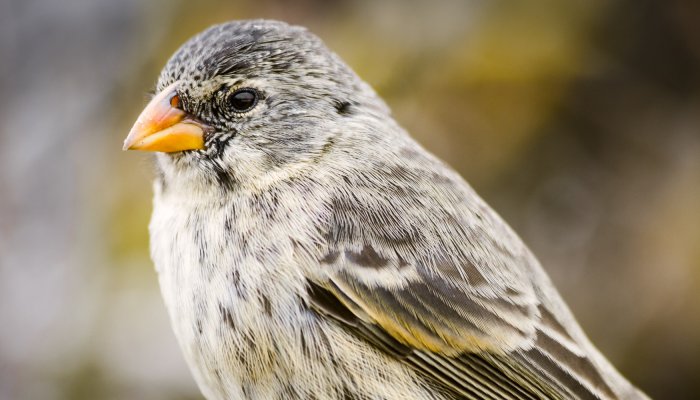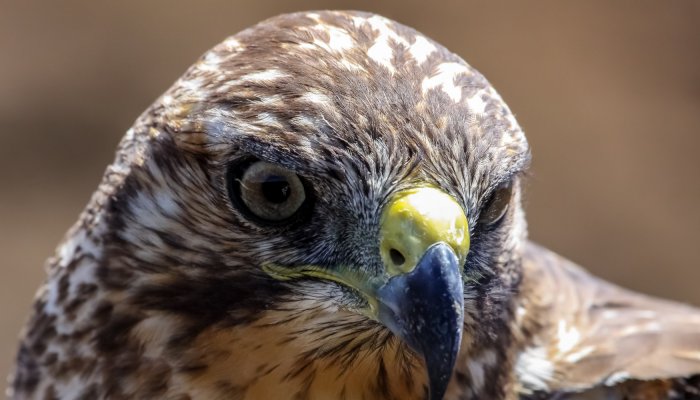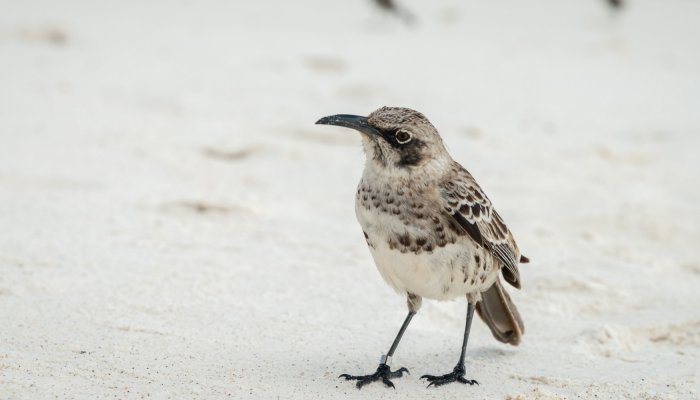
Blue-footed boobies
A Galapagos Guarantee Creature!
Blue-footed boobies are perhaps the most distinctive. These boobies don’t need blue suede shoes, because their feet are fabulously blue all on their own. In fact, blue-footed boobies take such pride in their bright blue tootsies that males strut their stuff to attract a mate—the bluer the feet, the more irresistible the bird.
Where to find blue-footed boobies:
The largest colonies of blue-footed boobies can be found on Española and Seymour, though they can be found throughout the Galápagos Islands. They breed on islands south of the equator, though sometimes they breed on Genovesa.
Experience blue-footed boobies in person on our Galápagos Island Explorer tour.

Red-footed boobies
Red-footed boobies also have that distinctive red-footed marker paired with a blue beak, though adults can be colored brown and white. Unlike the boobies who are often seen plodding along and nesting on the ground, the red-footed boobies create their nesting colonies in trees.
Their courtship also has an arboreal bent, so if you happen to look up into a tree and spot a red-footed booby perched on a branch, lifting its feet and waving them around in front of a coquettish female, you’re the lucky witness of wooing booby.
Red-footed boobies are partially nocturnal, feed farther away from land, and spend much of their time aloft in trees. As such, they’re less frequently seen cruising around the Galapagos than other boobies, even though they happen to be the most numerous.
Where to find red-footed boobies:
While you can see red-footed boobies at sea, they breed on Seymour, San Cristóbal, and Genovesa Islands.

Nazca boobies
Nazca boobies are the largest of the booby birds found on the Galápagos Islands. With white-bibbed bodies and black feathers, without vividly colored feet, the Nazca boobies blend in a bit more with the crowd. Perhaps because their feet aren’t as interesting, they don’t bother trying to court potential mates by showing them off. Instead, Nazca boobies perform a dance ritual upon the ground. When females fly overhead, they point to all of their attributes—those fine feathers, nice beak, and manly chest—and point up to the sky while whistling to get the female’s attention. It’s essentially a booby version of a cat call.
Where to find Nazca boobies:
Nazca boobies can be seen flying over the sea. They breed on the steep slopes of Genovesa and Española and can occasionally be seen on San Cristóbal.
FUN FACT:
Nazca boobies lay two eggs—but only one chick survives. In a practice known as “obligatory sibling murdering,” one chick consumes most of the food in an effort to grow faster and larger. Once the chick is the biggest chick around, it kicks its weaker sibling out of the nest. The abandoned chick dies from thirst or from the elements, and the parent Nazca boobies don’t intervene.

GALAPAGOS PENGUIN
The ancestors of the Galápagos penguins must have been intrepid explorers, as they originally followed the Humboldt Current from Antarctica to the Galapagos. The Galapagos penguin seeks heat rather than cold, black lava rock rather than frozen tundra, and the north rather than the south. Although they only reach a bit above the equator, they are the northernmost penguins to be found.
Of course, the Galapagos penguins do still prefer the islands to be on their colder side. The penguins depend on the colder temperatures brought in by the Humboldt Current and the cold, nutrient-rich water brought up from deep waters by the Cromwell Current. In recent history, El Niño and its environmental repercussions resulted in a shockingly high mortality rate of around 77%. Though the populations are beginning to increase, they continue to be the most endangered and rare penguin species on the planet.
Galapagos penguins they nest in the fissures and caves of volcanic rock. To help penguin repopulation amidst nest devastation, scientists have construct over 120 “condos” for penguins as artificial nest sites.
It’s a good thing the Galapagos penguins have solid homes as they mate for life and do not follow a strict breeding season; instead they are known as opportunistic breeders and can produce around 3 clutches a year.
Where to find Galapagos penguins:
Even amongst the Galapagos Islands, their small populations are largely concentrated on Isabela and Fernandina Islands—with some sightings on Bartolomé, Floreana, and Santiago.
FUN FACT:
To cool off in the balmy Galapagos heat, the Galapagos penguins hold their flippers out as they move around the shoreline. Their purpose for this flipper stretch is two-fold: one, it helps them cool down their bodies; two, holding their flippers over their feet creates a shady patch that protects their feet from getting a sunburn.
You can best see these amazing birds on our signature Galapagos kayak tour.

FLIGHTLESS (GALAPAGOS) CORMORANT
When visiting the Galapagos, you won’t find these endemic cormorants flying… well, anywhere. Their large, elongated bodies only bear stunted wings that don’t get them and their big webbed feet off the ground. Much like our friend Opus the Penguin, these cormorants have a wish for wings that work.
Cormorants don’t let their stumpy wings keep them down (*wink wink* see what we did there?), and instead rely on their other awesome assets to eat, move around, and court one another. Cormorants don’t need to preen their feathers to snag a mate; instead, couples twine their lanky necks together and then twirl around in a circle before settling down to nest.
For other practical concerns, cormorants rely on their wide feet marked by four webbed toes. These, along with their wings kept aloft for balance, allow them to hop nimbly from rock to rock. Their feet also make for powerful paddles when diving deep in the ocean in search of eels and octopus (their primary food source). Unlike penguins who can find some form of flight underwater, cormorants don’t even bother with their wings and keep them tucked in while using their hind legs to propel them deeper. Then, their long, flexible necks are helpful in spearing eels and octopus from their coral sanctuaries.
Where to find flightless Galapagos cormorants:
When visiting the Galapagos, you’ll find flightless cormorants hopping from rock to rock on the coasts of Isabela and Fernandina Islands. If they are out on the ocean, you’ll have to look closely—they keep their lower bodies largely submerged below the surface with only their neck held above.

GALAPAGOS FRIGATEBIRDS
Frigatebirds: the great and magnificent! Of course, these are actual designations rather than an attempt to wax lyrical. Great and Magnificent frigatebirds can be seen soaring high above the archipelago, as they are largely aerial birds who often stay in flight for over a week. They don’t swim and aren’t that great at walking either, so if you spot one on cliffs or up in the trees, they are mostly down to roost or breed.
If you’re looking for frigatebirds of the Magnificent variety, look out for a dark seabird with a broad wingspan and forked tail. Oh ya, and a giant red gular sac that inflates like a balloon when the males are hoping to get some female attention. Great frigatebirds are just as magnificent really, and they look incredibly similar besides having a green sheen across their mantle and a pale bar spread along their upperwing. Both Magnificent and Great frigatebird females have white markings along their breasts and lack the vivid red gular sac.
Where to find Great and Magnificent Frigatebirds:
Seymour has the most constantly lively colony of magnificent frigatebirds. Great frigatebirds tend to be found on the outer islands of the archipelago.
Kayak through habitats of frigatebirds on our Galápagos Islands Vacation.

GALAPAGOS WAVED ALBATROSS
The Galapagos Albatross is the largest of the Galapagos birds, with its wingspan stretching from around 7-8 feet. Though they’re excellent gliders, they aren’t named for how they wave on the wind or float on the sea; rather they were named for the wave-like pattern that adorns their wings.
Though the waved albatross is so good at flying, they rarely wander far from home and are found only on Isla Española. Upon Española, they separate into two major colonies. When they do venture out to see, usually from January to March, they make it to the coasts of mainland Ecuador and Peru. If they need a break while flying, they gather in rafts while floating along idly with the waves.
Where to find Galapagos waved albatross:
Waved albatross can be seen on Española, where there’s an area aptly named “albatross airport,” as well as the southern islands of the archipelago.
FUN FACT:
Ah… of love and lobsters. While Friends’ Phoebe declared the penultimate love to be that of lobsters, it turns out that Phoebe was a big fat liar. While lobsters do have monogamous relationships that extend beyond a brief but passionate one-night stand, the flings only last a couple of weeks before they seek action elsewhere. But no worries—they were on a break.
Waved albatrosses, however, are monogamous and mate for life after an incredible courtship ritual dance that can go on for years. Even after flying far across the sea, waved albatrosses return to Española and to their partner each year.

LAVA GULL
The Lava Gull is one of the rarest gulls in the world, and the entire population is found in the Galapagos as another of the archipelago’s many endemic species. With fewer than 400 pairs found throughout the island, the population is seen as vulnerable yet steady.
Befitting their name, Lava Gulls look like they’ve been rolling around in charcoal with their black head and wings paired with a gray body. Their unique coloring makes them easy to spot as they scavenge along the tideline.
Where to find lava gulls:
The largest populations of lava gulls can be found in the populated ports of the central Galapagos Islands as well as Genovesa.

GALAPAGOS/DARWIN’S FINCHES
Darwin’s Galapagos finches are the most famous birds in the Galapagos, and may be some of science’s most famous birds as well. The thing to remember about Galápagos finches is that the Galapagos has multiple species of finches—13 to be exact. Their diversification is, in fact, the entire reason they became famous in the first place.
Darwin collected nine species of finches (in the traditional 19th century method, by shooting them) and realized that the populations varied by island. All of this led up to the “Transmutation of Species,” though Darwin’s notes on the finches are surprisingly scattershot.
Though Galapagos finches have found their place in history, they are rather diminutive birds. Small, with generally dull feathered colored black, brown, or olive, the most interesting thing about them is their bills which vary in size and shape—the varying detail which inspired that grand theory we call evolution.
Where to find Galapagos finches:
Galapagos finches are spread throughout the Galapagos Islands, with different species inhabiting different islands together.

GALAPAGOS HAWK
The GalApagos hawk is the only diurnal raptor to be found in the archipelago, so if you hear a “kee-kee-kee” or spot a large bird of prey with a hooked bill… you’ve found yourself a hawk. They inhabit most of the Galapagos Islands and have a variety of habitats ranging from the highlands to the coast. Their nests are usually found in the dry lowlands, so you might be able to see them from a kayak or from a cruise!
Where to find the Galapagos hawk:
Galapagos hawks can be spotted on Española, Fernandina, Isabela, Santa Fé, Santiago, Bartolomé, and South Plaza Islands.

GALAPAGOS GREATER FLAMINGO
These long-necked, pink birds won’t be found dotting lawns in the Galapagos, but painstakingly constructing mud nests in brackish lagoons.
Flamingoes in general are social creatures who live in large congregations. Galapagos flamingos, however, live and breed in smaller groups than anywhere else in the world—perhaps an adaptation to their lives on the remote islands.
Where to find the Galapagos greater flamingo:
Their favorite saline lakes are on Floreana Island, but colonies can be spotted on Rábida, Santa Cruz, Santiago, and Isabela. Encounter these iconic island birds on our Galapagos Islands Cruise.
FUN FACT:
Even though they’re found in such dower surroundings, the Galapagos flamingos are thought to be the most vividly colored flamingo found in the world.

ESPAÑOLA/HOOD MOCKINGBIRD
The Española, or Hood, mockingbird is true to its name and can be found only on Española and Gardner-by-Española. Like much of the wildlife throughout the Galápagos, the Española mockingbird is incredibly fearless of visitors, and it is not unheard of for one of them to take a break from flight and perch on the head of one of Española’s visitors. With a long bill marked by a downward curve, blackish-brown or brownish-grey coloring, and a long, dark brown tail, the Española mockingbird blends in well with the thorny, mesquite scrub on the island.
Where to find the Española/Hood Mockingbird:
As its name indicates, the Española mockingbird can only be found on Española Island and Gardner-by-Española.
FUN FACT:
The Española Mockingbird is the Galapagos’ only known vampires, and they have a serious blood craving. These mockingbirds are unique in that they often drink blood—particularly in the dry season—from the wounds of animals like sea lions. Some have been known to try to snack on a human’s leg wounds.

